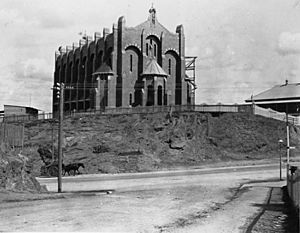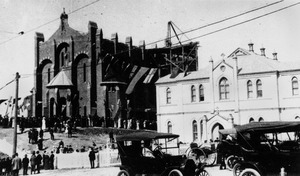St Brigid's Church, Red Hill facts for kids
Quick facts for kids St Brigid's Church, Red Hill |
|
|---|---|

St Brigids Church, 2009
|
|
| Location | 78 Musgrave Road, Red Hill, City of Brisbane, Queensland, Australia |
| Design period | 1900 - 1914 (early 20th century) |
| Built | 1912 - 1914 |
| Architect | Robin Dods |
| Architectural style(s) | Arts & Crafts |
| Official name: St Brigids Church | |
| Type | state heritage (built) |
| Designated | 21 October 1992 |
| Reference no. | 600284 |
| Significant period | 1912-1914 (fabric) |
| Significant components | furniture/fittings, pipe organ, stained glass window/s |
| Builders | Thomas Keenan |
| Lua error in Module:Location_map at line 420: attempt to index field 'wikibase' (a nil value). | |
St Brigid's Church is an old and important Catholic church in Red Hill, Brisbane, Australia. It was designed by a famous architect named Robin Dods. The church was built between 1912 and 1914 by Thomas Keenan. Because it's so special, it was added to the Queensland Heritage Register on October 21, 1992.
Contents
History of St Brigid's Church
The very first St Brigid's Church in Red Hill opened on December 30, 1882. This church replaced an even older stone building from 1877.
As more and more people joined the church, it became one of the biggest parishes in Brisbane. They needed a much larger church that could hold about 1000 people. The foundation stone for the current church was placed on May 5, 1912. The building was then constructed from 1912 to 1914.
Many people in the parish were poor Irish immigrants. This made the church a very important place for the Irish Catholic community in Queensland.
Grand Opening Ceremony
The church was officially opened on August 9, 1914. This was a huge event for the Catholic community in Brisbane. Important leaders attended, like Archbishop Daniel Mannix from Melbourne. The ceremony was led by Archbishop James Duhig from Brisbane.
Building St Brigid's was seen as a sign that Catholicism in Brisbane was growing strong. Archbishop Duhig later became famous for building many churches and schools. St Brigid's was a great start for him.
St Brigid's School
There used to be a St Brigid's School, but it is no longer open. The closest school now is the Petrie Terrace State School. It is located down the hill in Paddington.
What St Brigid's is Used For Today
Today, St Brigid's Church is part of the Jubilee Catholic Parish. This parish includes seven churches and three schools. They are all located in the inner western suburbs of Brisbane.
Design and Architecture
Location and View
St Brigid's Church is very important because it stands out on the Brisbane skyline. You can see it from many different directions. The church is built high up on Red Hill. It faces north-south, which is unusual for a church. This means it lines up perfectly with the view down George Street. This view was once blocked but is now clear again. Its high position near the city makes it a famous landmark in Brisbane.
The church's location also shows how Archbishop Duhig wanted to build churches in important spots. It also represents how confident Catholicism was becoming in Queensland, especially among the Irish immigrants.
Building Style
The church looks like a strong, brick fortress. It has a rectangular shape. The front entrance, the altar area (chancel), and the supporting walls (buttresses) are shaped like a semi-octagon. A small, one-story room called a vestry sticks out from the west side of the altar area.
The architect, Robert Smith Dods (also known as Robin S. Dods), was inspired by St Ceciles Cathedral in France. The church building committee actually chose this French cathedral as the model for St Brigid's. St Brigid's is an amazing example of Robin Dods's architectural style, both inside and out.
His design shows ideas from the Arts and Crafts style. This style focuses on using natural materials and making buildings fit beautifully into their surroundings. Many parts of the church help keep it cool. These include the tall ceilings, windows with small balconies, arches, and French doors.
The original plan for the church included a tall tower above the altar area. However, this tower was never built because there wasn't enough money. Above the entrance, there is a life-size statue of St Brigid by LJ Harvey. She holds a small model of what the completed church was supposed to look like.
Inside the Church
The inside of St Brigid's is simple and doesn't have a lot of fancy decorations. However, it feels very grand because of its huge size. The details and craftsmanship in the brick, stone, wood, glass, and metal are simple but very well done.
Some special features inside include the timber ceiling, the light fixtures, the gallery, the organ, the altars, and the stained glass windows. Some of the original silky oak and leadlight doors on the sides of the church have been replaced. Now there are clear glass areas that let in a lot of light at floor level.
The Pipe Organ
St Brigid's has a recently fixed and updated pipe organ. It is located in the choir loft and its music can fill the entire church.
Why St Brigid's is a Heritage Site
St Brigid's Church was added to the Queensland Heritage Register on October 21, 1992. This means it is considered very important for several reasons:
- It shows how Queensland's history has changed over time. It's an example of how Archbishop Duhig wanted to build churches in important places. It also shows how Catholicism, especially among Irish immigrants, became more confident in Queensland.
- It is a great example of a certain type of important building. It's a key part of the Brisbane skyline and can be seen from everywhere. It's also an amazing example of Robin Dods's architecture. He was a well-known architect in the Arts and Crafts movement.
- It is beautiful and important for its design. The church was planned to create a stunning view on the George Street axis. The inside of the church is also very impressive. This is because of the careful way materials, light, and size were combined.



